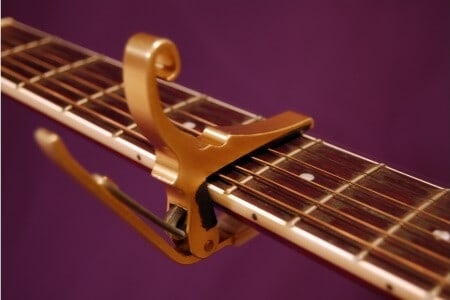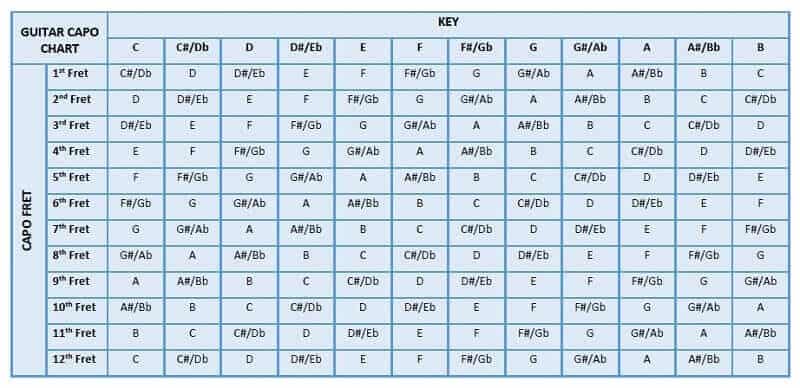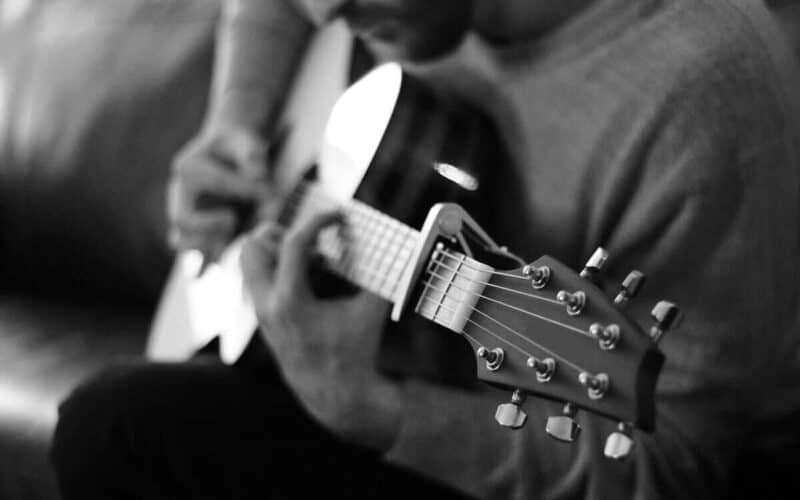If you want to take that extra step to sound better and make playing the guitar more fun then you could turn to the capo. Many guitarists incorporate the use of the capo and it is indeed a great skill to master how to use a guitar capo for the best musical experience.
Welcome to today’s lesson in which we will provide you with all the information you need on this handy tool (capos) and how you can make the best use of it.
If you are passionate about guitar playing and changing the sound to complement your voice or choice of songs you wish to play using the best guitar capo like a trigger capo then with the help of our beginner’s guide you will learn to do just that. So without further ado let us get into this guitar capos guide.
Initially, we will answer 3 important questions:
1. What is a capo?
2. How does it work?
3. What is its purpose?
What Is A Capo?

A capo is a tool that you can use while playing the guitar or some other stringed instruments like the ukulele, banjos, mandolins, etc. to modify the sound or raise the tuning of the instrument to the desired level.
How Does A Capo Work?
A capo looks and works simply like a clamp. It needs to be positioned at a point on the fretboard and ‘clamped’ down. You will need to loosen the capo to move it up and down the fretboard until you reach your targeted fret and then close the capo to lock it in place. Once this is done, all the strings on that particular fret will be pressed down.
What Is The Purpose Of A Capo On A Guitar?
The main purpose of a capo is to raise the key of the guitar. If you are having difficulty with complex chords down the neck then a capo will enable you to attempt them with more ease without changing the chord shapes.
While playing the guitar with a capo you can maintain the same chord voicings though you change the original key. You will be able to use the same open-position chord forms but the notes will be different. For example, let us say that you have placed the capo on the first fret and played a C chord, the sound that will be produced will be a C#.
However, if you place the capo on the second fret then the sound will be of a D chord. This is because moving the capo up just one fret will raise the chord half a step while moving the capo up two frets will move up the tone a full step.
In simple words, you must play thinking that the fret below the capo is the first fret when you use a capo.

How To Use A Capo For Beginners: Main Steps
Moving on we will now get to know some steps to use a capo on the guitar. The two main steps involved are:
a) positioning the tool and
b) playing with it.
We have explained both the steps below in the simplest way possible so even beginners can figure out and get a clear understanding of how to use the capo.
A) Positioning The Capo
Step 1– You may need to turn to the sheet music that tells you which fret to place your capo on or as a beginner guitarist just use it on the first, second, or third fret to get used to the change in tone. Slide your open capo to the desired fret and clamp it down. This should press and hold all the strings down on the fretboard.
Step 2– Depending on the type of capo you need to make sure that the tension is distributed evenly so that the sound produced will be smooth. In order to do so, you must avoid tightening the capo while it is in the middle of a fret. Move the capo closer to the edge of the fret and closer to the body of the guitar before tightening it.
B) Guitar Playing With The Capo
Strategy # 1: Tuning your guitar is crucial because it determines how the notes will sound when you play. There are several tuning techniques but the most common one for beginners is to go by the E, A, D, G, B, E rule. Always start from the top moving on to the bottom.
Strategy # 2: First play the chords openly without using the capo. If you know how the chords sound naturally by ear, it’ll be easier and faster for you to pick up the newly made sounds with the addition of a capo.
Strategy # 3: Know that bringing a capo further down will enhance the tone of the chords you’ll be playing. This will allow you to make a more upbeat and buoyant melody. Before choosing a specific fret to cover the rest of the song you wish to play, try experimenting by positioning the capo on each fret and playing so you can learn what kind of sounds will be created through each fret.
Strategy # 4: There is plenty of transposition charts or capo chart all over the internet and this can turn out to be of big help when you’re new to learning how to use a capo on the guitar. Transposition charts help by letting you know various chord shapes and which chord you are actually playing at the moment by showing you a visual representation of where your capo is placed.

Strategy # 5: Before you start playing songs with a capo on, you need to clearly understand and identify the difference a capo makes when added to a guitar. You will be able to use open chords but once you put on the capo on a specific fret, the open chord notes will be altered.
Even if your finger position on the fretboard is the same as always, the notes emitted will not be the same as it used to be before a capo was introduced to the fretboard.
Strategy # 6: Most of us take up guitar lessons as a hobby but there are some people among us who are aspiring artists or in a school band, hence increasing the necessity to learn how to play properly with a capo on while playing with others.
While it doesn’t seem like a problem, as a capo alters the note of a chord entirely, it can be confusing for every person in the group to make sure they’re all playing the same note. That is why it is necessary for everyone playing the guitar with a capo to be on the same page.
As you know, there are seven chords for each of the keys and they correspond accordingly. The capo you will have on will change the chords when placed on the fret, so move it up and down in order to find the correct fret you are happy playing in.
Check out this YouTube video on how to transpose using a capo:
Frequently Asked Questions
How do I know which key to place a capo on?
First try playing different keys in whatever position or way you want, to get the sound of it. For example, the G chord, A minor, B minor, C, D, E minor, and F diminished can be played without using a capo.
Hence you can play the G key with a capo on the fifth, seventh and tenth fret. But know that playing the guitar with a capo this high on the fingerboard can come off sounding a bit odd at first on most guitars.
Can you use a capo on an electric guitar?
Yes, you can use a capo on an electric guitar. If you can’t achieve the tonality you want via barre chords and instead want to use open chords, then a capo would make sense on an electric guitar. In this case, a capo will play quite the same role as your index finger do in a barre chord.
But needless to say, you may need to adjust the tension of the capo differently from what you have on your acoustic guitar.
Is playing with a capo cheating?
Playing with a capo isn’t cheating if you want to change the tonality of the guitar to better suit the song you are playing. Using a capo, in this case, is justified because it allows you to easily play such open chords that would be very challenging with barre chords.
In contrast, if you are using a capo because you don’t have the skill, then one could consider it cheating. If you’re lazy to learn the guitar and view a capo as a tool that would make playing guitar easier, then yeah, that could be called cheating.
Do beginners need a capo?
Capos could be very useful for beginner guitar players, but they don’t really need them. They have plenty of other things to learn – how to hold the guitar correctly, how to play different chords, and which strings to hold. Additionally, beginners should learn music theory, memorize chords, and practice a lot.
Capos do make playing the guitar somewhat easier, but in the long term, this is a downside rather than an advantage for newbies. You need to learn the basics first – if you just use a capo to skip learning a few chords, you will actually be hampering your progress.
So don’t use a capo unless you absolutely need it to produce the sound your music needs.
Our Recommended Capos
- Shubb S1 Stainless Steel Guitar Capo for Steel String Guitars
- G7th Performance 3 Capo with ART (Steel String Silver)
- Thalia Blue Abalone Capo
- D’Addario NS Tri-Action Capo For 6-String Electric and Acoustic Guitars
- Ernie Ball Axis Dual Radius Capo



Thank you. This was very well written and most informative. I have purchased several capos and in general they are fine . However even though it was recommended for my twelve string guitar the last one I purchased still is still a bit short. Can you recommend one that will defiantly fit and do the job?
It’s tricky to match a capo for 12-string guitar due to different neck shapes and sizes. It would not be wise to recommend any capo without knowing anything about your guitar. But for 12-string guitar, I prefer Paige Clik Guitar Capo (PC-12-2.250-R) or G7th New Port (C32013). I hope you would find the best match for your 12-string guitar. Thanks.